| Listing 1 - 7 of 7 |
Sort by
|
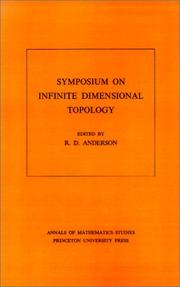
ISBN: 0691080879 1400881404 9780691080871 Year: 1972 Volume: 69 Publisher: Princeton, N.J.
Abstract | Keywords | Export | Availability | Bookmark
 Loading...
Loading...Choose an application
- Reference Manager
- EndNote
- RefWorks (Direct export to RefWorks)
In essence the proceedings of the 1967 meeting in Baton Rouge, the volume offers significant papers in the topology of infinite dimensional linear spaces, fixed point theory in infinite dimensional spaces, infinite dimensional differential topology, and infinite dimensional pointset topology. Later results of the contributors underscore the basic soundness of this selection, which includes survey and expository papers, as well as reports of continuing research.
Topology --- Differential geometry. Global analysis --- Differential topology --- Functional analysis --- Congresses --- Analyse fonctionnnelle --- Geometry, Differential --- Anderson's theorem. --- Annihilator (ring theory). --- Automorphism. --- Baire measure. --- Banach algebra. --- Banach manifold. --- Banach space. --- Bounded operator. --- Cartesian product. --- Characterization (mathematics). --- Cohomology. --- Compact space. --- Complement (set theory). --- Complete metric space. --- Connected space. --- Continuous function. --- Convex set. --- Coset. --- Critical point (mathematics). --- Diagram (category theory). --- Differentiable manifold. --- Differential topology. --- Dimension (vector space). --- Dimension. --- Dimensional analysis. --- Dual space. --- Duality (mathematics). --- Endomorphism. --- Equivalence class. --- Euclidean space. --- Existential quantification. --- Explicit formulae (L-function). --- Exponential map (Riemannian geometry). --- Fixed-point theorem. --- Fréchet derivative. --- Fréchet space. --- Fuchsian group. --- Function space. --- Fundamental class. --- Haar measure. --- Hessian matrix. --- Hilbert space. --- Homeomorphism. --- Homology (mathematics). --- Homotopy group. --- Homotopy. --- Inclusion map. --- Infimum and supremum. --- Lebesgue space. --- Lefschetz fixed-point theorem. --- Limit point. --- Linear space (geometry). --- Locally convex topological vector space. --- Loop space. --- Mathematical optimization. --- Measure (mathematics). --- Metric space. --- Module (mathematics). --- Natural topology. --- Neighbourhood (mathematics). --- Normal space. --- Normed vector space. --- Open set. --- Ordinal number. --- Paracompact space. --- Partition of unity. --- Path space. --- Product topology. --- Quantifier (logic). --- Quotient space (linear algebra). --- Quotient space (topology). --- Radon measure. --- Reflexive space. --- Representation theorem. --- Riemannian manifold. --- Schauder fixed point theorem. --- Sign (mathematics). --- Simply connected space. --- Space form. --- Special case. --- Stiefel manifold. --- Strong operator topology. --- Subcategory. --- Submanifold. --- Subset. --- Tangent space. --- Teichmüller space. --- Theorem. --- Topological space. --- Topological vector space. --- Topology. --- Transfinite induction. --- Transfinite. --- Transversal (geometry). --- Transversality theorem. --- Tychonoff cube. --- Union (set theory). --- Unit sphere. --- Weak topology. --- Weakly compact. --- Differential topology - Congresses --- Functional analysis - Congresses --- Topology - Congresses --- Analyse fonctionnelle.
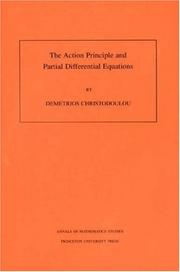
ISBN: 0691049572 0691049564 1400882680 Year: 2000 Volume: no. 146 Publisher: Princeton Princeton University press
Abstract | Keywords | Export | Availability | Bookmark
 Loading...
Loading...Choose an application
- Reference Manager
- EndNote
- RefWorks (Direct export to RefWorks)
This book introduces new methods in the theory of partial differential equations derivable from a Lagrangian. These methods constitute, in part, an extension to partial differential equations of the methods of symplectic geometry and Hamilton-Jacobi theory for Lagrangian systems of ordinary differential equations. A distinguishing characteristic of this approach is that one considers, at once, entire families of solutions of the Euler-Lagrange equations, rather than restricting attention to single solutions at a time. The second part of the book develops a general theory of integral identities, the theory of "compatible currents," which extends the work of E. Noether. Finally, the third part introduces a new general definition of hyperbolicity, based on a quadratic form associated with the Lagrangian, which overcomes the obstacles arising from singularities of the characteristic variety that were encountered in previous approaches. On the basis of the new definition, the domain-of-dependence theorem and stability properties of solutions are derived. Applications to continuum mechanics are discussed throughout the book. The last chapter is devoted to the electrodynamics of nonlinear continuous media.
Differentiaalvergelijkingen [Hyperbolische ] --- Differential equations [Hyperbolic] --- Equations différentielles hyperboliques --- Symplectic manifolds --- Differential equations, Hyperbolic. --- Symplectic manifolds. --- Variétés symplectiques --- Equations différentielles hyperboliques --- Variétés symplectiques --- Manifolds, Symplectic --- Geometry, Differential --- Manifolds (Mathematics) --- Hyperbolic differential equations --- Differential equations, Partial --- Action (physics). --- Boundary value problem. --- Canonical form. --- Causal structure. --- Classical mechanics. --- Complex analysis. --- Configuration space. --- Conservative vector field. --- Conserved current. --- Conserved quantity. --- Continuum mechanics. --- Derivative. --- Diffeomorphism. --- Differentiable manifold. --- Differential geometry. --- Dimension. --- Dimensional analysis. --- Dirichlet's principle. --- Einstein field equations. --- Electromagnetic field. --- Equation. --- Equations of motion. --- Equivalence class. --- Error term. --- Euclidean space. --- Euler system. --- Euler's equations (rigid body dynamics). --- Euler–Lagrange equation. --- Existence theorem. --- Existential quantification. --- Exponential map (Lie theory). --- Exponential map (Riemannian geometry). --- Exterior derivative. --- Fiber bundle. --- Foliation. --- Fritz John. --- General relativity. --- Hamiltonian mechanics. --- Hamilton–Jacobi equation. --- Harmonic map. --- Hessian matrix. --- Holomorphic function. --- Hyperbolic partial differential equation. --- Hyperplane. --- Hypersurface. --- Identity element. --- Iteration. --- Iterative method. --- Lagrangian (field theory). --- Lagrangian. --- Legendre transformation. --- Lie algebra. --- Linear approximation. --- Linear differential equation. --- Linear map. --- Linear span. --- Linearity. --- Linearization. --- Maximum principle. --- Maxwell's equations. --- Nonlinear system. --- Open set. --- Ordinary differential equation. --- Orthogonal complement. --- Parameter. --- Partial differential equation. --- Phase space. --- Pointwise. --- Poisson bracket. --- Polynomial. --- Principal part. --- Principle of least action. --- Probability. --- Pullback bundle. --- Pullback. --- Quadratic form. --- Quantity. --- Requirement. --- Riemannian manifold. --- Second derivative. --- Simultaneous equations. --- Special case. --- State function. --- Stokes' theorem. --- Subset. --- Surjective function. --- Symplectic geometry. --- Tangent bundle. --- Tangent vector. --- Theorem. --- Theoretical physics. --- Theory. --- Underdetermined system. --- Variable (mathematics). --- Vector bundle. --- Vector field. --- Vector space. --- Volume form. --- Zero of a function. --- Zero set.
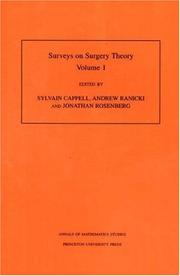

ISBN: 0691049386 0691088152 1322055211 1400865190 0691049378 1322063281 1400865212 0691088144 9781400865192 9780691049380 9780691049373 9781400865215 9780691088150 9780691088150 9780691088143 Year: 2014 Volume: 145,149 Publisher: Princeton, NJ
Abstract | Keywords | Export | Availability | Bookmark
 Loading...
Loading...Choose an application
- Reference Manager
- EndNote
- RefWorks (Direct export to RefWorks)
Surgery theory, the basis for the classification theory of manifolds, is now about forty years old. The sixtieth birthday (on December 14, 1996) of C.T.C. Wall, a leading member of the subject's founding generation, led the editors of this volume to reflect on the extraordinary accomplishments of surgery theory as well as its current enormously varied interactions with algebra, analysis, and geometry. Workers in many of these areas have often lamented the lack of a single source surveying surgery theory and its applications. Because no one person could write such a survey, the editors asked a variety of experts to report on the areas of current interest. This is the second of two volumes resulting from that collective effort. It will be useful to topologists, to other interested researchers, and to advanced students. The topics covered include current applications of surgery, Wall's finiteness obstruction, algebraic surgery, automorphisms and embeddings of manifolds, surgery theoretic methods for the study of group actions and stratified spaces, metrics of positive scalar curvature, and surgery in dimension four. In addition to the editors, the contributors are S. Ferry, M. Weiss, B. Williams, T. Goodwillie, J. Klein, S. Weinberger, B. Hughes, S. Stolz, R. Kirby, L. Taylor, and F. Quinn.
Chirurgie (Topologie) --- Heelkunde (Topologie) --- Surgery (Topology) --- Differential topology --- Homotopy equivalences --- Manifolds (Mathematics) --- Topology --- Algebraic topology (object). --- Algebraic topology. --- Ambient isotopy. --- Assembly map. --- Atiyah–Hirzebruch spectral sequence. --- Atiyah–Singer index theorem. --- Automorphism. --- Banach algebra. --- Borsuk–Ulam theorem. --- C*-algebra. --- CW complex. --- Calculation. --- Category of manifolds. --- Characterization (mathematics). --- Chern class. --- Cobordism. --- Codimension. --- Cohomology. --- Compactification (mathematics). --- Conjecture. --- Contact geometry. --- Degeneracy (mathematics). --- Diagram (category theory). --- Diffeomorphism. --- Differentiable manifold. --- Differential geometry. --- Dirac operator. --- Disk (mathematics). --- Donaldson theory. --- Duality (mathematics). --- Embedding. --- Epimorphism. --- Excision theorem. --- Exponential map (Riemannian geometry). --- Fiber bundle. --- Fibration. --- Fundamental group. --- Group action. --- Group homomorphism. --- H-cobordism. --- Handle decomposition. --- Handlebody. --- Homeomorphism group. --- Homeomorphism. --- Homology (mathematics). --- Homomorphism. --- Homotopy extension property. --- Homotopy fiber. --- Homotopy group. --- Homotopy. --- Hypersurface. --- Intersection form (4-manifold). --- Intersection homology. --- Isomorphism class. --- K3 surface. --- L-theory. --- Limit (category theory). --- Manifold. --- Mapping cone (homological algebra). --- Mapping cylinder. --- Mostow rigidity theorem. --- Orthonormal basis. --- Parallelizable manifold. --- Poincaré conjecture. --- Product metric. --- Projection (linear algebra). --- Pushout (category theory). --- Quaternionic projective space. --- Quotient space (topology). --- Resolution of singularities. --- Ricci curvature. --- Riemann surface. --- Riemannian geometry. --- Riemannian manifold. --- Ring homomorphism. --- Scalar curvature. --- Semisimple algebra. --- Sheaf (mathematics). --- Sign (mathematics). --- Special case. --- Sub"ient. --- Subgroup. --- Submanifold. --- Support (mathematics). --- Surgery exact sequence. --- Surgery obstruction. --- Surgery theory. --- Symplectic geometry. --- Symplectic vector space. --- Theorem. --- Topological conjugacy. --- Topological manifold. --- Topology. --- Transversality (mathematics). --- Transversality theorem. --- Vector bundle. --- Waldhausen category. --- Whitehead torsion. --- Whitney embedding theorem. --- Yamabe invariant.
Book
ISBN: 0691197547 Year: 2019 Publisher: Princeton, NJ : Princeton University Press,
Abstract | Keywords | Export | Availability | Bookmark
 Loading...
Loading...Choose an application
- Reference Manager
- EndNote
- RefWorks (Direct export to RefWorks)
Arithmetic and Geometry presents highlights of recent work in arithmetic algebraic geometry by some of the world's leading mathematicians. Together, these 2016 lectures-which were delivered in celebration of the tenth anniversary of the annual summer workshops in Alpbach, Austria-provide an introduction to high-level research on three topics: Shimura varieties, hyperelliptic continued fractions and generalized Jacobians, and Faltings height and L-functions. The book consists of notes, written by young researchers, on three sets of lectures or minicourses given at Alpbach.The first course, taught by Peter Scholze, contains his recent results dealing with the local Langlands conjecture. The fundamental question is whether for a given datum there exists a so-called local Shimura variety. In some cases, they exist in the category of rigid analytic spaces; in others, one has to use Scholze's perfectoid spaces.The second course, taught by Umberto Zannier, addresses the famous Pell equation-not in the classical setting but rather with the so-called polynomial Pell equation, where the integers are replaced by polynomials in one variable with complex coefficients, which leads to the study of hyperelliptic continued fractions and generalized Jacobians.The third course, taught by Shou-Wu Zhang, originates in the Chowla-Selberg formula, which was taken up by Gross and Zagier to relate values of the L-function for elliptic curves with the height of Heegner points on the curves. Zhang, X. Yuan, and Wei Zhang prove the Gross-Zagier formula on Shimura curves and verify the Colmez conjecture on average.
Arithmetical algebraic geometry. --- Algebraic geometry, Arithmetical --- Arithmetic algebraic geometry --- Diophantine geometry --- Geometry, Arithmetical algebraic --- Geometry, Diophantine --- Number theory --- Abelian variety. --- Algebraic geometry. --- Algebraic independence. --- Algebraic space. --- Analytic number theory. --- Arbitrarily large. --- Automorphic form. --- Automorphism. --- Base change. --- Big O notation. --- Class number formula. --- Cohomology. --- Complex multiplication. --- Computation. --- Conjecture. --- Conjugacy class. --- Continued fraction. --- Cusp form. --- Diagram (category theory). --- Dimension. --- Diophantine equation. --- Diophantine geometry. --- Discriminant. --- Divisible group. --- Double coset. --- Eisenstein series. --- Endomorphism. --- Equation. --- Existential quantification. --- Exponential map (Riemannian geometry). --- Fiber bundle. --- Floor and ceiling functions. --- Formal group. --- Formal power series. --- Formal scheme. --- Fundamental group. --- Geometric Langlands correspondence. --- Geometry. --- Heegner point. --- Hodge structure. --- Hodge theory. --- Homomorphism. --- I0. --- Integer. --- Intersection number. --- Irreducible component. --- Isogeny. --- Isomorphism class. --- Jacobian variety. --- L-function. --- Langlands dual group. --- Laurent series. --- Linear combination. --- Local system. --- Logarithmic derivative. --- Logarithmic form. --- Mathematics. --- Modular form. --- Moduli space. --- Monotonic function. --- Natural topology. --- P-adic analysis. --- P-adic number. --- Pell's equation. --- Perverse sheaf. --- Polylogarithm. --- Polynomial. --- Power series. --- Presheaf (category theory). --- Prime number. --- Projective space. --- Quaternion algebra. --- Rational point. --- Real number. --- Reductive group. --- Rigid analytic space. --- Roth's theorem. --- Series expansion. --- Shafarevich conjecture. --- Sheaf (mathematics). --- Shimura variety. --- Siegel zero. --- Special case. --- Stack (mathematics). --- Subset. --- Summation. --- Szpiro's conjecture. --- Tate conjecture. --- Tate module. --- Taylor series. --- Theorem. --- Theta function. --- Topological ring. --- Topology. --- Torsor (algebraic geometry). --- Upper and lower bounds. --- Vector bundle. --- Weil group. --- Witt vector. --- Zariski topology.
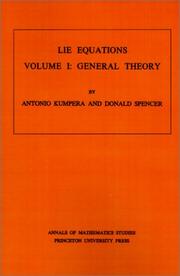
ISBN: 0691081115 9780691081113 1400881730 Year: 1972 Volume: 73 Publisher: Princeton (N.J.) Princeton university press
Abstract | Keywords | Export | Availability | Bookmark
 Loading...
Loading...Choose an application
- Reference Manager
- EndNote
- RefWorks (Direct export to RefWorks)
In this monograph the authors redevelop the theory systematically using two different approaches. A general mechanism for the deformation of structures on manifolds was developed by Donald Spencer ten years ago. A new version of that theory, based on the differential calculus in the analytic spaces of Grothendieck, was recently given by B. Malgrange. The first approach adopts Malgrange's idea in defining jet sheaves and linear operators, although the brackets and the non-linear theory arc treated in an essentially different manner. The second approach is based on the theory of derivations, and its relationship to the first is clearly explained. The introduction describes examples of Lie equations and known integrability theorems, and gives applications of the theory to be developed in the following chapters and in the subsequent volume.
Differential geometry. Global analysis --- Lie groups --- Lie algebras --- Differential equations --- Groupes de Lie --- Algèbres de Lie --- Equations différentielles --- 514.76 --- Groups, Lie --- Symmetric spaces --- Topological groups --- Algebras, Lie --- Algebra, Abstract --- Algebras, Linear --- Equations, Differential --- Bessel functions --- Calculus --- Geometry of differentiable manifolds and of their submanifolds --- Differential equations. --- Lie algebras. --- Lie groups. --- 517.91 Differential equations --- 514.76 Geometry of differentiable manifolds and of their submanifolds --- Algèbres de Lie --- Equations différentielles --- 517.91. --- Numerical solutions --- Surfaces, Deformation of --- Surfaces (mathématiques) --- Déformation --- Pseudogroups. --- Pseudogroupes (mathématiques) --- 517.91 --- Adjoint representation. --- Adjoint. --- Affine transformation. --- Alexander Grothendieck. --- Analytic function. --- Associative algebra. --- Atlas (topology). --- Automorphism. --- Bernhard Riemann. --- Big O notation. --- Bundle map. --- Category of topological spaces. --- Cauchy–Riemann equations. --- Coefficient. --- Commutative diagram. --- Commutator. --- Complex conjugate. --- Complex group. --- Complex manifold. --- Computation. --- Conformal map. --- Continuous function. --- Coordinate system. --- Corollary. --- Cotangent bundle. --- Curvature tensor. --- Deformation theory. --- Derivative. --- Diagonal. --- Diffeomorphism. --- Differentiable function. --- Differential form. --- Differential operator. --- Differential structure. --- Direct proof. --- Direct sum. --- Ellipse. --- Endomorphism. --- Equation. --- Exact sequence. --- Exactness. --- Existential quantification. --- Exponential function. --- Exponential map (Riemannian geometry). --- Exterior derivative. --- Fiber bundle. --- Fibration. --- Frame bundle. --- Frobenius theorem (differential topology). --- Frobenius theorem (real division algebras). --- Group isomorphism. --- Groupoid. --- Holomorphic function. --- Homeomorphism. --- Integer. --- J-invariant. --- Jacobian matrix and determinant. --- Jet bundle. --- Linear combination. --- Linear map. --- Manifold. --- Maximal ideal. --- Model category. --- Morphism. --- Nonlinear system. --- Open set. --- Parameter. --- Partial derivative. --- Partial differential equation. --- Pointwise. --- Presheaf (category theory). --- Pseudo-differential operator. --- Pseudogroup. --- Quantity. --- Regular map (graph theory). --- Requirement. --- Riemann surface. --- Right inverse. --- Scalar multiplication. --- Sheaf (mathematics). --- Special case. --- Structure tensor. --- Subalgebra. --- Subcategory. --- Subgroup. --- Submanifold. --- Subset. --- Tangent bundle. --- Tangent space. --- Tangent vector. --- Tensor field. --- Tensor product. --- Theorem. --- Torsion tensor. --- Transpose. --- Variable (mathematics). --- Vector bundle. --- Vector field. --- Vector space. --- Volume element. --- Surfaces (mathématiques) --- Déformation --- Analyse sur une variété
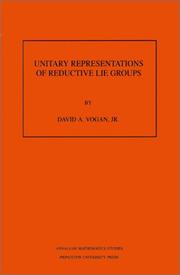
ISBN: 0691084815 0691084823 1400882389 9780691084824 9780691084817 Year: 1987 Publisher: Princeton Princeton University Press
Abstract | Keywords | Export | Availability | Bookmark
 Loading...
Loading...Choose an application
- Reference Manager
- EndNote
- RefWorks (Direct export to RefWorks)
This book is an expanded version of the Hermann Weyl Lectures given at the Institute for Advanced Study in January 1986. It outlines some of what is now known about irreducible unitary representations of real reductive groups, providing fairly complete definitions and references, and sketches (at least) of most proofs. The first half of the book is devoted to the three more or less understood constructions of such representations: parabolic induction, complementary series, and cohomological parabolic induction. This culminates in the description of all irreducible unitary representation of the general linear groups. For other groups, one expects to need a new construction, giving "unipotent representations." The latter half of the book explains the evidence for that expectation and suggests a partial definition of unipotent representations.
Lie groups --- Representations of Lie groups --- Lie groups. --- Representations of Lie groups. --- 512.81 --- Groups, Lie --- Lie algebras --- Symmetric spaces --- Topological groups --- 512.81 Lie groups --- Abelian group. --- Adjoint representation. --- Annihilator (ring theory). --- Atiyah–Singer index theorem. --- Automorphic form. --- Automorphism. --- Cartan subgroup. --- Circle group. --- Class function (algebra). --- Classification theorem. --- Cohomology. --- Commutator subgroup. --- Complete metric space. --- Complex manifold. --- Conjugacy class. --- Cotangent space. --- Dimension (vector space). --- Discrete series representation. --- Dixmier conjecture. --- Dolbeault cohomology. --- Duality (mathematics). --- Eigenvalues and eigenvectors. --- Exponential map (Lie theory). --- Exponential map (Riemannian geometry). --- Exterior algebra. --- Function space. --- Group homomorphism. --- Harmonic analysis. --- Hecke algebra. --- Hilbert space. --- Hodge theory. --- Holomorphic function. --- Holomorphic vector bundle. --- Homogeneous space. --- Homomorphism. --- Induced representation. --- Infinitesimal character. --- Inner automorphism. --- Invariant subspace. --- Irreducibility (mathematics). --- Irreducible representation. --- Isometry group. --- Isometry. --- K-finite. --- Kazhdan–Lusztig polynomial. --- Langlands decomposition. --- Lie algebra cohomology. --- Lie algebra representation. --- Lie algebra. --- Lie group action. --- Lie group. --- Mathematical induction. --- Maximal compact subgroup. --- Measure (mathematics). --- Minkowski space. --- Nilpotent group. --- Orbit method. --- Orthogonal group. --- Parabolic induction. --- Principal homogeneous space. --- Principal series representation. --- Projective space. --- Pseudo-Riemannian manifold. --- Pullback (category theory). --- Ramanujan–Petersson conjecture. --- Reductive group. --- Regularity theorem. --- Representation of a Lie group. --- Representation theorem. --- Representation theory. --- Riemann sphere. --- Riemannian manifold. --- Schwartz space. --- Semisimple Lie algebra. --- Sheaf (mathematics). --- Sign (mathematics). --- Special case. --- Spectral theory. --- Sub"ient. --- Subgroup. --- Support (mathematics). --- Symplectic geometry. --- Symplectic group. --- Symplectic vector space. --- Tangent space. --- Tautological bundle. --- Theorem. --- Topological group. --- Topological space. --- Trivial representation. --- Unitary group. --- Unitary matrix. --- Unitary representation. --- Universal enveloping algebra. --- Vector bundle. --- Weyl algebra. --- Weyl character formula. --- Weyl group. --- Zariski's main theorem. --- Zonal spherical function. --- Représentations de groupes de Lie --- Groupes de lie --- Representation des groupes de lie
Book
ISBN: 9781400863174 1400863171 0691632553 Year: 2014 Publisher: Princeton, NJ
Abstract | Keywords | Export | Availability | Bookmark
 Loading...
Loading...Choose an application
- Reference Manager
- EndNote
- RefWorks (Direct export to RefWorks)
The aim of this work is to provide a proof of the nonlinear gravitational stability of the Minkowski space-time. More precisely, the book offers a constructive proof of global, smooth solutions to the Einstein Vacuum Equations, which look, in the large, like the Minkowski space-time. In particular, these solutions are free of black holes and singularities. The work contains a detailed description of the sense in which these solutions are close to the Minkowski space-time, in all directions. It thus provides the mathematical framework in which we can give a rigorous derivation of the laws of gravitation proposed by Bondi. Moreover, it establishes other important conclusions concerning the nonlinear character of gravitational radiation. The authors obtain their solutions as dynamic developments of all initial data sets, which are close, in a precise manner, to the flat initial data set corresponding to the Minkowski space-time. They thus establish the global dynamic stability of the latter.Originally published in 1994.The Princeton Legacy Library uses the latest print-on-demand technology to again make available previously out-of-print books from the distinguished backlist of Princeton University Press. These editions preserve the original texts of these important books while presenting them in durable paperback and hardcover editions. The goal of the Princeton Legacy Library is to vastly increase access to the rich scholarly heritage found in the thousands of books published by Princeton University Press since its founding in 1905.
Space and time --- Generalized spaces --- Nonlinear theories --- Physics --- Physical Sciences & Mathematics --- Atomic Physics --- Nonlinear problems --- Nonlinearity (Mathematics) --- Calculus --- Mathematical analysis --- Mathematical physics --- Geometry of paths --- Minkowski space --- Spaces, Generalized --- Weyl space --- Calculus of tensors --- Geometry, Differential --- Geometry, Non-Euclidean --- Hyperspace --- Relativity (Physics) --- Space of more than three dimensions --- Space-time --- Space-time continuum --- Space-times --- Spacetime --- Time and space --- Fourth dimension --- Infinite --- Metaphysics --- Philosophy --- Space sciences --- Time --- Beginning --- Mathematics --- Angular momentum operator. --- Asymptotic analysis. --- Asymptotic expansion. --- Big O notation. --- Boundary value problem. --- Cauchy–Riemann equations. --- Coarea formula. --- Coefficient. --- Compactification (mathematics). --- Comparison theorem. --- Corollary. --- Covariant derivative. --- Curvature tensor. --- Curvature. --- Cut locus (Riemannian manifold). --- Degeneracy (mathematics). --- Degrees of freedom (statistics). --- Derivative. --- Diffeomorphism. --- Differentiable function. --- Eigenvalues and eigenvectors. --- Eikonal equation. --- Einstein field equations. --- Equation. --- Error term. --- Estimation. --- Euclidean space. --- Existence theorem. --- Existential quantification. --- Exponential map (Lie theory). --- Exponential map (Riemannian geometry). --- Exterior (topology). --- Foliation. --- Fréchet derivative. --- Geodesic curvature. --- Geodesic. --- Geodesics in general relativity. --- Geometry. --- Hodge dual. --- Homotopy. --- Hyperbolic partial differential equation. --- Hypersurface. --- Hölder's inequality. --- Identity (mathematics). --- Infinitesimal generator (stochastic processes). --- Integral curve. --- Intersection (set theory). --- Isoperimetric inequality. --- Laplace's equation. --- Lie algebra. --- Lie derivative. --- Linear equation. --- Linear map. --- Logarithm. --- Lorentz group. --- Lp space. --- Mass formula. --- Mean curvature. --- Metric tensor. --- Minkowski space. --- Nonlinear system. --- Normal (geometry). --- Null hypersurface. --- Orthonormal basis. --- Partial derivative. --- Poisson's equation. --- Projection (linear algebra). --- Quantity. --- Radial function. --- Ricci curvature. --- Riemann curvature tensor. --- Riemann surface. --- Riemannian geometry. --- Riemannian manifold. --- Sard's theorem. --- Scalar (physics). --- Scalar curvature. --- Scale invariance. --- Schwarzschild metric. --- Second derivative. --- Second fundamental form. --- Sobolev inequality. --- Sobolev space. --- Stokes formula. --- Stokes' theorem. --- Stress–energy tensor. --- Symmetric tensor. --- Symmetrization. --- Tangent space. --- Tensor product. --- Theorem. --- Trace (linear algebra). --- Transversal (geometry). --- Triangle inequality. --- Uniformization theorem. --- Unit sphere. --- Vector field. --- Volume element. --- Wave equation. --- Weyl tensor.
| Listing 1 - 7 of 7 |
Sort by
|

 Search
Search Feedback
Feedback About UniCat
About UniCat  Help
Help News
News